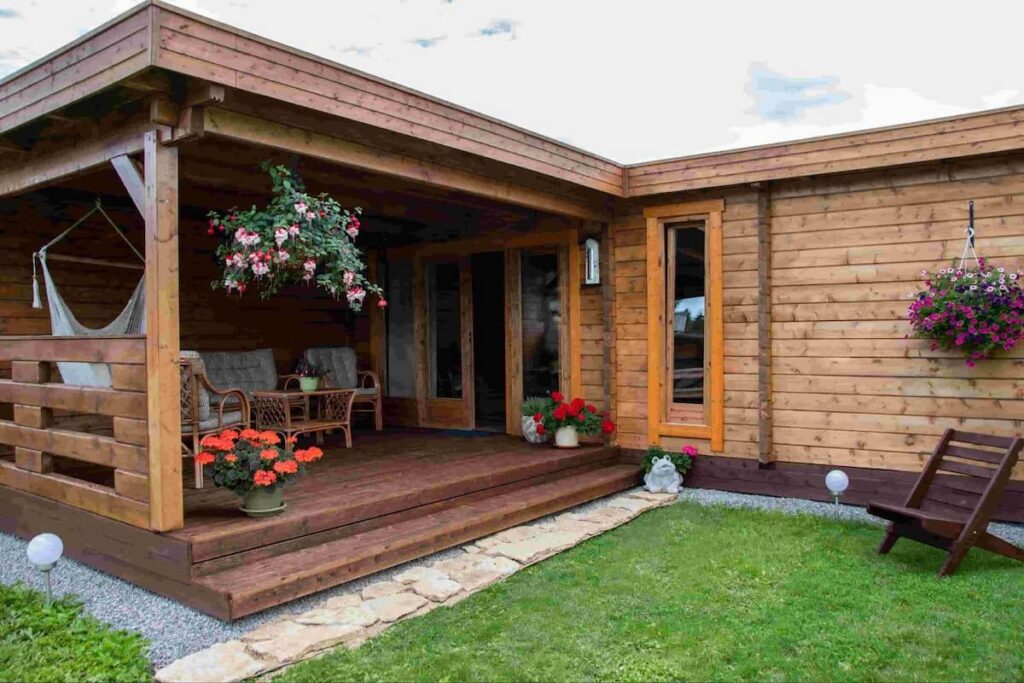Do you want to find out how wooden garden house ventilation works? In our blog post, we talk about the importance of proper airflow and learn about different ventilation methods. You’ll learn why ventilation matters and learn some effective ways to keep your garden retreat comfortable and well-maintained.

In the photo above: Hansa Deluxe garden room with a veranda
Proper ventilation – or air movement – is essential for any garden room, including wooden ones. The good news is that it’s very straightforward. Simply opening windows and doors is enough. For instance, tilt and turn windows, which are standard in all Summerhouse24 garden houses, let you conveniently control the airflow.
Have you ever noticed the fresh air in log cabins compared to modern buildings? This is partly due to the unique properties that wood has. Wooden structures are often said to “breathe”, because they let moisture move through them. This process makes the wood expand and contract, which means wooden buildings are engineered with a little bit of extra space to let this process happen. These small gaps provide small openings for air to move through.
Some signs tell you the building has a problem with ventilation. Here’s what you should look out for:
There’s no need to panic if you notice increased windows condensation. This is normal during rainy or cold weather.
To effectively deal with the excess moisture you can consider using the following options:
It’s important to protect your garden room or log cabin from moisture. Make sure the wooden garden building is properly treated and don’t leave the building unattended for long periods when the weather is cold or rainy.
When wood is exposed to too much moisture, it can warp or become damaged. It’s good to know that thinner wood is more likely to warp, which is why almost all of Casetasdejardin24’s garden room’s wall planks are made from thick wood – at least 44mm.

In the photo above: Garden House Elias
Here’s a short overview of the types of additional ventilation you can use for your wooden garden house.
Ventilation Options:
Natural air circulation is easy to achieve by keeping your windows slightly open. Having openings on the opposite sides of a building is the most effective way, because for air to be able to move it needs a way in and a way out.
For additional ventilation, two vents can be installed. One at the front of the garden room and one at the back. It’s best to have the building positioned in a way that the prevailing winds hit the gable end of the building – creating more natural air movement. To keep out rodents or bugs, add screens to the vent openings.
You can use gable vents, wall vents or even a roof vent like a whirligig to increase passive ventilation in your garden room.
Gable vents are installed at the gable ends (triangular ends of a building’s roof). They can both be placed high up, or one can be positioned low – to facilitate better air movement.
In bigger buildings, gable vents can be paired with wall vents. The wall vents will be placed close to the floor. The air will come in through the wall vents and exit through the gable vents. It’s worth noting that the vents should have the right balance of intake and exhaust.
Whirligigs are dome-shaped vents that are installed on the roof. When the wind blows, it makes the whirligig spin, which creates a vacuum. They’re usually used with other types of vents – like wall vents – and they can be effective in pulling out the hot air.
In Spain, an electric air conditioner can make the perfect addition to your wooden garden house. With an AC you’re always in control and your garden sanctuary is always at just the right temperature – even during a heatwave
ACs are great for dehumidifying your cabin or garden room, especially if you live in a coastal area. It’s also good to consider the cost of electric heating and cooling. Choose an air conditioning unit that is energy efficient to save money.
An AC with a smart controller can be a great choice if you want to cool or warm up your garden room or cabin ahead of time, especially if it’s located further away.
Get a dual-function air conditioner to keep you warm when it’s cold and to heat up your garden nest when the temperatures drop.
Natural airflow is easy to achieve in wooden garden buildings and additional ventilation isn’t typically needed. When you open doors and windows sufficient air circulation is guaranteed. Additional ventilations options can be beneficial when issues come up, but they are generally not needed for most wooden garden houses and log cabins.